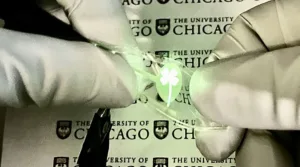Researchers at the Pritzker School of Molecular Engineering at the University of Chicago have made a significant breakthrough in the development of stretchable, light-emitting materials. They have created a new polymer that can harness all excitons through thermally activated delayed fluorescence, achieving a near-unity theoretical quantum yield. By inserting flexible, linear units into the polymer backbone, the team achieved a stretchability of 125% (if the polymer was initially 10 cm long, it could stretch up to 22.5 cm before breaking), with an external quantum efficiency of 10% (for every 100 units of electrical energy applied to the polymer, it emits 10 units of light energy). The stretchable and flexible digital display material developed by the researchers has the potential for a wide range of applications, including wearable electronics and health sensors, as well as foldable computer screens.
The researchers achieved stretchability in their new material by inserting flexible linear units into the polymer backbone, which can bend in half or stretch to more than twice its original length while still emitting a fluorescent pattern. This third-generation mechanism for organic emitters can provide materials with performance on par with commercial OLED technologies. Furthermore, the development of stretchable displays has the potential to improve wearable sensors that require light to function, such as those that measure blood oxygenation and heart rate by shining a light through blood vessels to sense blood flow.
Reference
Liu, W., Zhang, C., Alessandri, R. et al. High-efficiency stretchable light-emitting polymers from thermally activated delayed fluorescence. Nat. Mater. (2023). https://doi.org/10.1038/s41563-023-01529-w

